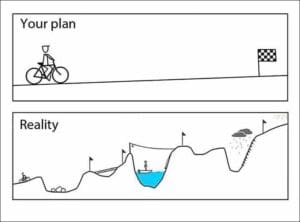Lean Business Planning

I received a call the other day from Danielle, a woman I met at a workshop I led. She wants to start a private chef business. She reached out to me because she wants to have everything planned out with a clear vision to set herself up for success. Great!
But as we talked, she had so many questions – would customers like her specific niche in the private chef world? Where would she cook? What is the right price? How much will it cost to produce an event? Even though I once ran a private chef business, I didn’t have answers for her; too much has changed since the days of Interactive Cuisine.
My advice: Just start! As someone who writes business plans for a living, this advice might seem surprising. Sometimes, though, the only way to get answers is to jump right in. For Danielle, “just starting” is a low-cost way to get the answers to her many questions. She can provide her services for a few months and see how it goes. The only investment is the cost of ingredients and her time. For other, aspiring entrepreneurs, with a higher cost of entry, “just starting” isn’t always an answer. Instead, consider working for someone else in a similar industry to start answering the many questions.
Recently, I’ve been reading about Lean Start-Ups. It’s a process for developing a product or service that has a constant cycle of feedback loops. At each stage of development, the entrepreneur solicits feedback from both customers and the staff. As this article suggests, Lean Start-Up is the antithesis of the business planning process.
The challenge with business plans, and the reason why they’re considered obsolete even before the ink dries, is that once they’re written they get filed on a shelf to gather dust. They are obsolete if you don’t go back to review and revise. That said, I do recommend writing a business plan, even if it’s just a few pages long. A business plan is a way to:
- clarify your vision,
- get the jumble of ideas out of your head and on paper,
- make sure you’ve considered all aspect of the business from development to production to marketing, and
- test the financial feasibility.

As you sketch out your plan, note the assumptions you make (or hypotheses in “lean” terms). Your ability to predict outcomes (profitability, customer acquisition rates, etc.) depends on the accuracy of your assumptions. If your hypothesis is true, and your assumptions correct, what do you expect will happen?
Once the business plan is written, and you begin to execute on your plan, you must constantly check back to make sure your assumptions (and there are many) are correct. Is your marketing strategy working? Are your costs what you expected? Are you customers asking for something you’re not offering? If your assumptions are off, then you need to make adjustments to your plan; and test a new hypothesis.
This process of comparing the business plan projections to actuals (or the plan to reality) is similar to the Lean Start-Up. The key is that the business planning and development process is iterative.
For Danielle, I suggested she sketch out an initial vision of the business by answering the following questions:
- What service are you providing?
- Who are your customers and why will they buy from you?
- How will you reach your customers? How will they find out about you?
- What will it cost to service your clients, considering both monetary and time?
- What will you charge?
And then go out and do it! After a few events, Danielle can revisit initial plan to see what worked and what didn’t. Were her assumptions correct as to how she’d find her customers? Did they value what she thought they would?In other words, were her hypotheses correct?
- Did her customers want the service she offered?
- Are the customers buying from her matching the profile she expected?
- Did her customers find her they way she expected they would?
- Did she spend more or less time and money on the events?
- Was her pricing strategy correct based on her costs and her actual customers?
With more informed answers to her questions, she can refine her plan (the service offering, the marketing strategy and the cost structure) and build on her successes.
Need more help with your business plan? Drop us a line.
